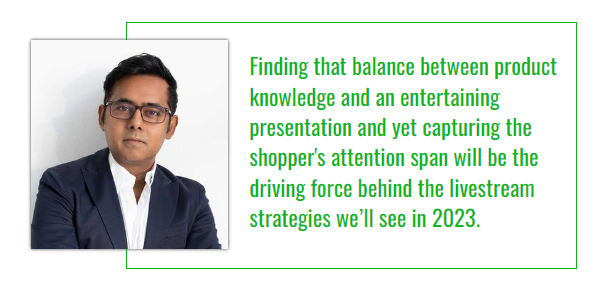In 2022, livestream shopping – an e-commerce staple in Asia, with a $322 billion market in China alone – exploded in the U.S. like never before, reaching a remarkable fervor during the holiday season. Major retailers such as Nordstrom, Levi Strauss and Bloomingdales are among the countless brands that hosted livestream shopping events this year, ushering in a new era of live video commerce in the States.
But if 2022 was the initial explosion, then 2023 will be the year live shopping goes fully mainstream. Below are three predictions for how that will manifest.

Fast forward to where we are today, the adults of Gen Z, the third largest generational segment in the U.S., are settling into the market. Digital natives, at their core, Gen Zers, are open to exploring new platforms and immersive experiences. A third will actually begin the shopper journey on social media and prefer brands with that personalized touch.
The behaviors that link all generations today stem from being connected consumers: navigates seamlessly through all channels, constantly present in an everywhere commerce environment, where all moments are shoppable–from where we scroll, browse, see, watch, read, essentially anywhere we interact with a brand. So for 2023, let’s focus on three areas centered around delivering experiences to the connected consumer.
Prediction 1: Boring e-commerce is out. Entertainment is in.
In 2023, live commerce won’t compete with your audience’s daily scroll through Amazon, but with their favorite streaming service(s). Live commerce is fundamentally a content strategy, and when you’re trying to get someone to buy a product, that content must be engaging enough to pique viewers’ interest in your offerings.
Right now, the biggest barrier to retailers adopting live selling is actually knowing how to do it. The execution is difficult; it’s hard to strike a balance between product knowledge and an entertaining presentation that can overcome our increasingly short attention spans.
Finding that balance will be the driving force behind the livestream strategies we’ll see in 2023. Everyone will engineer their own brand-specific recipe for entertainment – in a sense, marketers are going to become showrunners.
Prediction 2: Authenticity, not celebrity, will be the key to engagement
Over the past decade, we’ve seen the rise of a new class of celebrity: the influencer. Like any celebrity, influencers have become the face of millions of marketing and advertising campaigns, valuable not only for their talent and fanbase, but their unprecedented proximity to the end consumer.
Consumers want to buy products from people who look and live like them, who model a lifestyle that’s attainable. Live selling is unique because it empowers business owners to become influencers themselves, creating a more personalized relationship between buyer and seller. Additionally, live selling pushes consumers through the conversion funnel faster, and in real-time. In 2023, we’ll see video commerce strategies focus more on engagement through authenticity, resulting in a more inclusive experience for audiences.
Prediction 3: Live selling strategies will be short-form and long-form
Live selling is just one act in the larger story of video commerce. Beyond live selling, brands have found success with explainers and “how-to”s, inspirational videos, short-form content, and the peer-to-peer recommendations that made the influencer an institution.
That said, many brands may believe they have to choose between long-form and short-form content strategies. This isn’t exactly unfounded, as Meta gutted its livestream shopping features earlier this year to focus on Reels, a sign that short-form will continue to be a focus for many retailers. But the same people who watch TikToks on their lunch break will also binge watch an entire Netflix series in a single weekend, or spend hours watching their favorite Twitch creator. At the end of the day, it’s not so much about the format of video commerce, but the content itself.
In 2023, more brands will discover that a good video commerce strategy isn’t about choosing between long-form and short-form, but finding the balance that allows them to best connect with their consumers. Live selling platforms enable sellers to utilize multiple channels of shopping; through reels, static images, stories, and replays, consumers have a unique opportunity to shop conveniently within a trusted community. After all, that’s the crux of why live commerce works in the first place: it fosters personal connection, and that’s what keeps people coming back.
Original Article Link is found here: https://magazine.retail-today.com